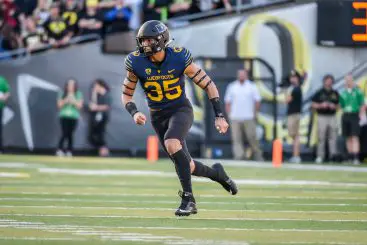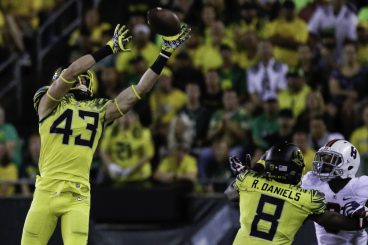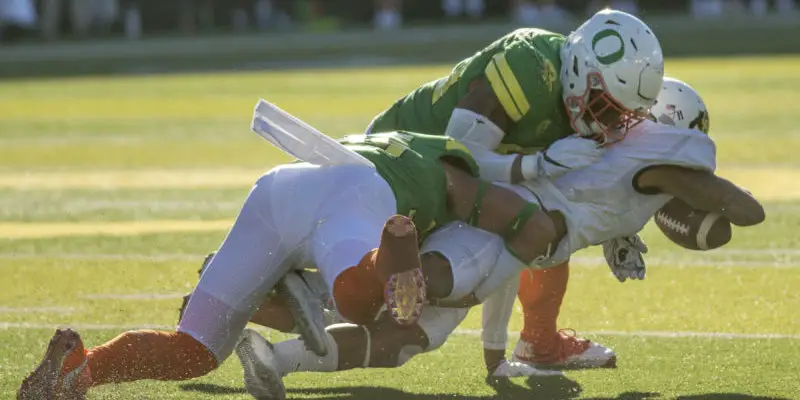Oregon’s defense, regardless of their (relatively) amiable performance against Arizona State this past weekend, is bad. Like historically bad. Prior to the game this weekend, the Ducks ranked in the bottom 10 in the country in rushing yards allowed per game, yards per rushing attempt and turnovers generated per game. They were 3rd-worst in total scoring defense and penalty yards allowed. They were dead last in first downs allowed per game. Those are make-your-eyes-bleed numbers for a defense.
That being said, explaining why Oregon’s defense is bad is tiring (I’m sure we all have dissected the reasons ad nauseam) and ultimately is a futile exercise. So instead, let’s look at the bright spots on the current defense – they exist, whether you believe it or not – and how the Ducks’ staff has recruited on that side of the ball.

Troy Dye is one of the few bright spots on a bad Ducks defense this season.
Any piece highlighting the bright spots on defense has to start with true freshman linebacker Troy Dye. While he’s missed a couple games due to injury, he has stood out in the majority of games in which he has played. Dye has averaged 7.71 tackles per game this season, which is the third-highest per game average among FBS freshmen. He also has 4.5 sacks and 1 interception on his resume in just six active games.
As a true freshman, these numbers are fairly impressive, but numbers can only tell you so much. If you watch Dye on the field, he plays with an intensity that the veterans on that side of the ball could actually learn from, and he seems to be in a position to make a tackle on every play. He’s a great fit as an outside linebacker in Brady Hoke’s 4-3 defense and he’ll only get better as he matures.
Another notable young gun on defense is safety Brenden Schooler, also a true freshman. Against Cal, Schooler had 11 tackles and he added 6 more this Saturday and was credited with half a sack. He also has 3 interceptions on the year, including his second-half pick this weekend. The young safety flies around the field in a very similar way to his classmate Dye, which shows on the stat sheet. His aggressiveness can get him into trouble, however; it occasionally causes him to break scheme and get beaten. The same is true of Dye. These are mistakes that are understandable in a true freshman and will become less frequent once the two players get more experience and seasoning.

Safety Brenden Schooler has shown a nose for the ball during his first season in Eugene.
Some other names of note have been freshman linebacker Keith Simms (mentioned in Charles Fischer’s article from last week, Linebacker Technique) and sophomore defensive end Jalen Jelks, who flashed early in the season before suffering a knee injury that kept him out of the four games prior to his 7-tackle return against Cal. Sophomore cornerback Ugo Amadi also received praise from the coaching staff after replacing the struggling Arrion Springs in the second half of the Cal game.
These young players are going to be the foundation of Oregon’s defense for the next three or four years, and that is reason enough to be optimistic. Even better, the Ducks have also recruited some talented defenders that could see the field as true freshmen next season.
Let’s start with 4-star cornerback Deommodore Lenoir (5’19, 191 lbs.), who made headlines a couple weeks ago when he responded to the now-famous report that only 30 to 40 percent of current Ducks “don’t even care if we win or lose.” Lenoir took to social media following the report and had this to say: “Well that mindset better change fast because spots will be taken period.” I love this. He’s not here to make friends. He’s here to take a starter’s job, play some football and win some games. Lenoir is coming to Eugene with an edge that this Ducks defense sorely needs. The fact that he’s a heck of a player doesn’t hurt either.
Lenoir also comes with a friend: fellow 4-star Jaylon Redd (5’8, 168 lbs.), who spent time at both wide receiver and cornerback at Rancho Cucamonga High School in California. He also happens to be the 4th-ranked ATH in the 2017 recruiting class. According to Rivals.com, the Oregon coaching staff sees Redd as a Charles Nelson-type player, with the ability to play offense, defense and special teams at an elite level. Redd’s game-changing speed could make him a potent offensive weapon in the Ducks’ system, but I hope that they utilize him primarily on defense. As much as I love watching Nelson’s electric play on offense and returning kicks, I would like to see Oregon use some of these elite-level athletes to shore up their biggest weakness: a lack of playmakers on defense.

Jaylon Redd plays his zone well and uses his exceptional burst to jump the route, taking advantage of an ill-advised throw by the opposing quarterback.
Oregon has also made strides at recruiting on the defensive line, which has really struggled to create pressure on opposing quarterbacks, at times. The Ducks hope 4-star defensive end Langi Tuifua can fill that role in the years to come. Unlike Lenoir and Redd, Tuifua probably won’t see the field immediately, mostly due to being a little smaller than the typical college defensive end at a paltry 205 lbs on a 6’3 frame. However, once he gets into a college weight lifting program and bulks up a bit, he will be hard to keep off the field. Tuifua has a great motor and shows a surprising strength for his size, which he used to punish smaller offensive lineman in high school. Where he really shines is when he uses his impressive speed to burn tackles around the edge, wreaking havoc on ball-carriers and quarterbacks behind the line of scrimmage.
This season is, and will continue to be, rough on defense for the Ducks. At this point, all the unit needs to do is gain some momentum heading into next season. The defense Saturday night against Arizona State looked better, especially in the pass-rushing and turnover departments. If this defense can force turnovers like it did against the Sun Devils on a semi-regular basis, they’ll be in much better shape down the stretch and into next season.
It is important to remember, however, that ASU has been absolutely decimated by injury on offense and still was able to score 35 points against the Ducks. That is the lowest amount of points a Pac-12 opponent has scored on the Ducks in 2016, and I’m not sure whether to be encouraged by the progress or despondent that the defense’s best effort is holding a rag-tag offense to five touchdowns and more than 450 yards of offense.
There are reasons to be excited about Oregon’s future defense, but Rome wasn’t built in a day. The Ducks aren’t going to lead the conference in total defense in 2017. That being said, it’s hard not to be at least somewhat encouraged by what we saw Saturday at Autzen Stadium the overall potential of the defense. Let’s just see some consistency before we get too excited.
Jay Garnett
Portland, Maine
Top Photo by Rhianna Gelhart
Disclaimer: Readers: Every writer on FishDuck.com is allowed to express their opinion in their articles. However, articles do not represent the views of the other writers, editors, coaching consultants, management, or the principals of FishDuck.com. Charles Fischer
Related Articles:
Oregon Enters Playoffs Better Off Than Last Year
Will The Coaching Carousel Kill Oregon's CFP Chances?
The Playoff Formula Hasn't Changed
Oregon Aims to Bury Dawgs, Punch Playoff Ticket in Rivalry Clash
Huskies Are the New Beavers, Stay In Your Lane Kiffin, and the Civil Apple Cup War
Oregon Football: The X-Factor Vs. Washington
Jay is a transplant to Duck Nation. He grew up in southern Maine, tragically knowing nothing of Oregon football prior to the 2007 college football season, when Dennis Dixon willed the Ducks into the national consciousness before tearing his ACL late in the year. Since then, the Ducks have consumed every Saturday from August to February. Jay graduated from the U of O with a degree in Journalism in the spring of 2014. Perhaps more impressively, he didn’t miss a single game in Autzen stadium during his four years in Eugene.

